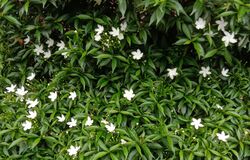Biology:Tabernaemontana divaricata
| Tabernaemontana divaricata | |
|---|---|

| |
| Scientific classification | |
| Kingdom: | Plantae |
| Clade: | Tracheophytes |
| Clade: | Angiosperms |
| Clade: | Eudicots |
| Clade: | Asterids |
| Order: | Gentianales |
| Family: | Apocynaceae |
| Genus: | Tabernaemontana |
| Species: | T. divaricata
|
| Binomial name | |
| Tabernaemontana divaricata R.Br. ex Roem. & Schult.
| |
| Synonyms[2] | |
|
List
| |
Tabernaemontana divaricata, commonly called pinwheel flower,[3] crape jasmine, East India rosebay, and Nero's crown,[4] is an evergreen shrub or small tree native to South Asia, Southeast Asia and China.[1] In zones where it is not hardy it is grown as a house/glasshouse plant for its attractive flowers and foliage. The stem exudes a milky latex when broken, whence comes the name milk flower

Description
The plant generally grows to a height of 1.5–1.8 metres (5–6 ft) and is dichotomously branched. The large shiny leaves are deep green and about 15 cm (6 in) in length and 5 cm (2 in) in width. The waxy blossoms are found in small clusters on the stem tips. The (single) flowers have the characteristic 'pinwheel' shape also seen in other genera in the family Apocynaceae such as Vinca and Nerium. Both single and double-flowered forms are cultivated, the flowers of both forms being white. The plant blooms in spring but flowers appear sporadically all year. The flowers have a pleasing fragrance.[5] More than 66 alkaloids are found in the shrub.[6] Its habitats include montane brushwoods and sparse forests.[7]
-
Tabernaemontana divaricata 'Flore Pleno'
-
Crape jasmine bunch
-
Tabernaemontana divaricata 'Pinwheel'
-
Tabernaemontana divarcata yet to blossom
-
Caterpillar of Oleander hawk-moth feeding on pinwheel flower plant
-
Flower buds of crape jasmine at night
Phytochemistry
The species is known to produce many alkaloids including catharanthine, coronaridine, dregamine, ibogamine, tabersonine, voacangine, voacamine and voacristine.[8] Ibogaine may occur in multiple Tabernaemontana species.[8]
Research
There is presence of potent acetylcholinestearase inhibitors in stems and roots of this plant. 3'-R/S-hydroxyvoacamine isolated from a stem extracts act as a non-competitive inhibitor against AChE with an IC50 value of 7.00±1.99 μM.[9] Bisindole alkaloid 19,20-dihydrotabernamine and 19,20-Dihydroervahanine A shows higher inhibitory activity on acetylcholinesterase compared with galanthamine.[10]
See also
References
- ↑ 1.0 1.1 Lakhey, P.; Pathak, J. (2020). "crape jasmine". IUCN Red List of Threatened Species 2020: e.T149853146A149853842. doi:10.2305/IUCN.UK.2020-3.RLTS.T149853146A149853842.en. https://www.iucnredlist.org/species/149853146/149853842. Retrieved 19 November 2021.
- ↑ "Tabernaemontana divaricata (L.) R.Br. ex Roem. & Schult.". Board of Trustees of the Royal Botanic Gardens, Kew. 2017. https://powo.science.kew.org/taxon/urn:lsid:ipni.org:names:82097-1.
- ↑ "Tabernaemontana divaricata". Natural Resources Conservation Service PLANTS Database. USDA. https://plants.usda.gov/core/profile?symbol=TADI5. Retrieved 7 December 2015.
- ↑ Medicinal Plants of India and Pakistan, Dastur J.F., pub.1962 by D.P. Taraporevala Sons and Co. Private Ltd., Mumbai, 4th Indian reprint 1977[page needed]
- ↑ The Royal Horticultural Society Dictionary of Gardening ed. Chittenden,Fred J. 2nd ed. by Synge,Patrick M. Volume IV : Pt-Zy, p.2074 (as T. coronaria). Pub. Oxford at the Clarendon Press 1965. Reprinted 1984. ISBN:0-19-869106-8
- ↑ Perry, Lily M. (1980). Medicinal Plants of East and Southeast Asia: Attributed Properties and Uses. MIT Press. ISBN 978-0-262-16076-6. https://archive.org/details/MedicinalP_00_Perr.[page needed]
- ↑ "Tabernaemontana divaricata in Flora of China @ efloras.org". http://www.efloras.org/florataxon.aspx?flora_id=2&taxon_id=210002194.
- ↑ 8.0 8.1 "Biologically active ibogan and vallesamine derivatives from Tabernaemontana divaricata". Chemistry and Biodiversity 1 (4): 646–56. April 2004. doi:10.1002/cbdv.200490056. PMID 17191876.
- ↑ "3'-R/S-hydroxyvoacamine, a potent acetylcholinesterase inhibitor from Tabernaemontana divaricata". Phytomedicine 20 (6): 543–8. April 2013. doi:10.1016/j.phymed.2012.12.016. PMID 23375813.
- ↑ "Vobasinyl-iboga bisindole alkaloids, potent acetylcholinesterase inhibitors from Tabernaemontana divaricata root". The Journal of Pharmacy and Pharmacology 58 (6): 847–52. June 2006. doi:10.1211/jpp.58.6.0015. PMID 16734986.
External links
Wikidata ☰ Q45150 entry
 |








